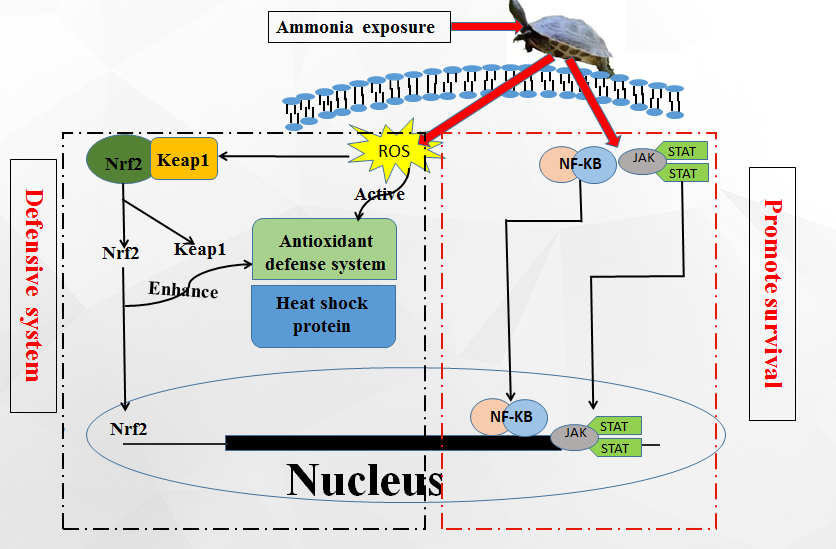
With the development of industrial and agricultural production, environmental pollution has been listed as one of the three major global crises together with ecological damage and resource shortage. Chelonians have a long life cycle, and their response to pollutants can be used to monitor the long-term effects of habitat pollution. Our team mainly focuses on ammonia nitrogen, nitrite, endocrine pollutants and pesticides as the main environmental stress factors, and studied the toxicological effects and mechanisms of different pollutants on chelonians, which can provide a reference basis for the diversity of this species and the protection of its habitat in its original authenticity.
1. Revealed the toxicological effects and mechanisms of ammonia nitrogen on chelonians
We found that a high ammonia environment significantly affects the antioxidant defence system of chelonians and induces inflammatory responses in chelonians through activation of the NF-κB signalling pathway; We revealed that ammonia nitrogen triggers endoplasmic reticulum stress through sustained activation of three branches of the unfolded protein response (PERK, ATF6, and IRE1) and activates its downstream transcription factor, CHOP, via ATF4, as well as activation of the JNK pathway by IRE1, which in turn regulates the expression of both anti-apoptotic and pro-apoptotic proteins, and consequently induces cell apoptosis; We also found that ammonia stress shortened the height of intestinal villi in chelonians, down-regulated the expression of mucin genes, up-regulated the expression of inflammatory factors IL-10, IL-12, TGF-β1, TNF-α, IFN-γ, etc., and altered the diversity of intestinal microorganisms, which resulted in a significant increase in pathogenic bacteria.

Figure High ammonia induces chelonians to intestinal inflammation and disrupts the mucosal barrier (Chemosphere. 2021)

Figure Effect of ammonia on oxidative stress and immune response in the liver of turtles (Aquatic Toxicology. 2020)
Figure Effect of ammonia on intestinal flora and glycolipid metabolism in the turtles (Ecotoxicol. Environ. Saf. 2021; Comp. Biochem. Physiol., Part C. 2023)
2.Discovered that butylparaben significantly affects the behaviour of chelonians, revealing the mechanism of apoptosis in the brain
Butylparaben (BuP) has potential endocrine disrupting effects as an endocrine disruptor with estrogen-like effects. It was found that the stress of BuP could affect the expression of 5-hydroxytryptamine receptors in brain, stimulate the expression of 5-hydroxytryptamine synthesis genes and transporter, and cause neurotransmitter system dysfunction, which interfered with the behaviours of chelonians, such as shortening of the sunbathing time, increase of the amount of food intake and the time of body-righting, decrease of the movement speed, and weakening of the ability to respond to external stimuli.



Fig. High concentration of BuP in the water environment induced abnormal behaviour and disturbance of the brain-gut axis in chelonians.
3. Found that environmental copper induced hepatic inflammation and apoptosis in chelonians

Fig. Environmental copper was significantly enriched in various tissues of chelonians, inducing liver inflammation and apoptosis (Front. Physiol. 2023)

 中文
中文 English
English





